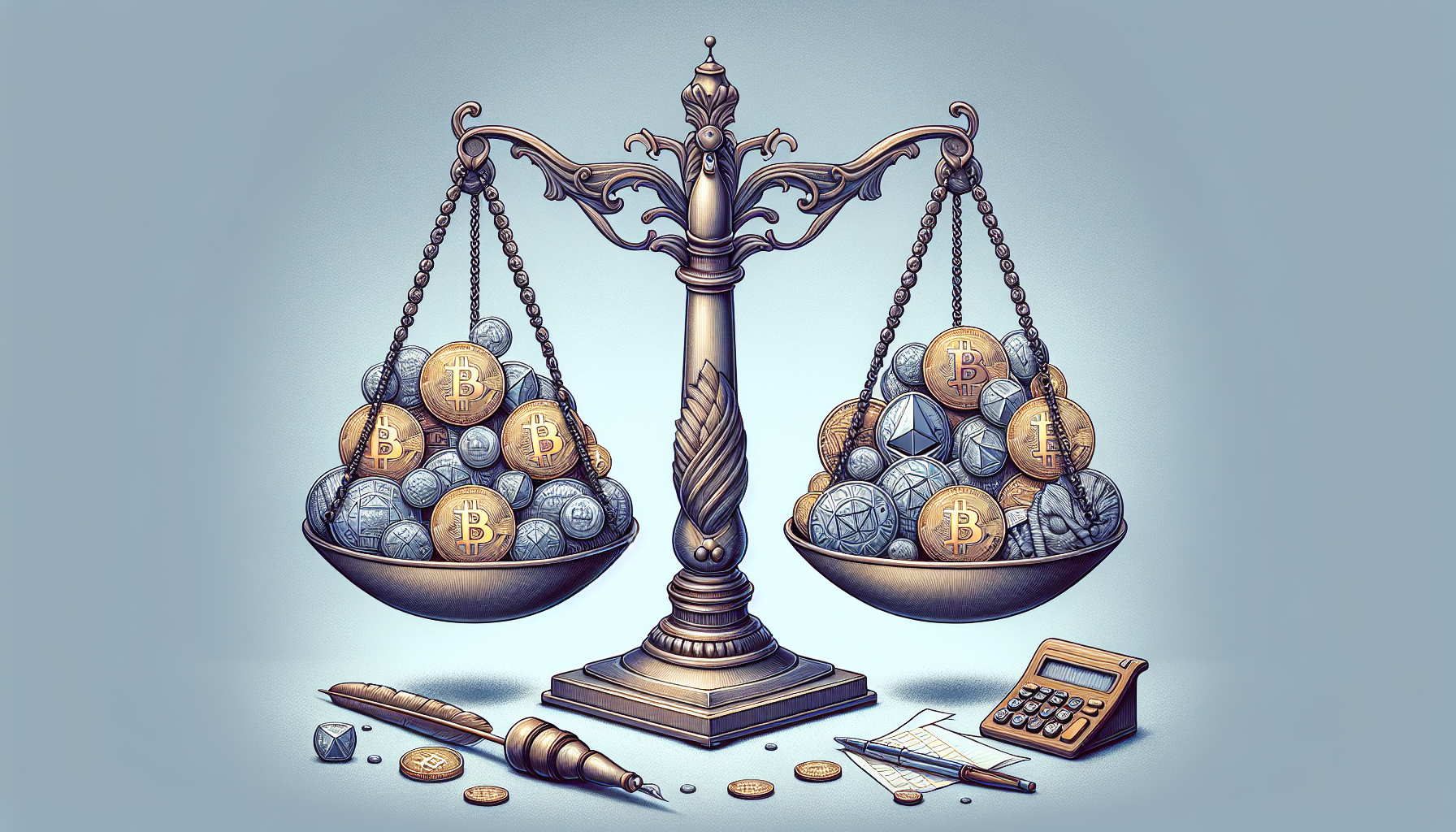Short Answer:
The SEC’s scrutiny, guided by the Howey Test, marks a tightrope walk between innovation and crypto securities regulation. High-profile cases and global regulatory efforts like the EU’s MiCA shape a landscape where transparency and adherence are paramount. Navigating these waters is crucial for market stability and investor protection.
Introduction & Background
With over a decade of experience in venture capital, M&A, and private equity transactions, including my time at AM Law 200 firm Locke Lord LLP, I’ve navigated complex legal landscapes that intertwine innovation and regulation. My expertise extends to the evolving world of cryptocurrencies, where the balance between groundbreaking technology and compliance with securities regulation presents unique challenges. The SEC’s intensified scrutiny on crypto assets underscores the critical need for legal guidance in navigating this dynamic field. Drawing on my legal acumen and experience, I aim to shed light on the intricacies of the securities landscape in crypto, helping stakeholders understand the delicate equilibrium between fostering innovation and adhering to regulatory mandates.
The cornerstone of crypto securities regulation, the Howey Test, is a testament to the intricate relationship between legal frameworks and technological advancements. My background in law, coupled with a keen interest in the transformative potential of digital assets, positions me uniquely to interpret the SEC’s regulatory cues and enforcement actions within the crypto space. With an eye on global regulatory trends and the pivotal role of transparency and due diligence, my perspective is grounded in a deep understanding of both the legal precedents and the forward-looking innovations shaping the future of cryptocurrency and crypto securities regulation.
Key Takeaways
-
Investors and crypto companies must navigate a complex landscape of SEC regulations, focusing on compliance with securities laws, understanding the Howey Test’s application to crypto assets, and aligning Initial Coin Offerings (ICOs) and tokens with existing mandates to avoid legal challenges.
-
The classification of cryptocurrencies as securities has significant implications, including possible delisting from exchanges and enhanced disclosure obligations for issuers, underscoring the importance of regulatory adherence to protect investors and maintain market integrity.
-
Global perspectives on crypto regulations vary, with the United States applying strict SEC oversight, the European Union seeking harmonization through MiCA, and the Asia-Pacific region exhibiting diverse regulatory responses, reflecting the nascent and evolving nature of crypto regulation worldwide.
Navigating the Crypto Securities Regulation Landscape
The SEC’s intensified scrutiny on the crypto space casts a formidable shadow across the industry. Investors must now thread the needle between innovation and compliance, ensuring their forays into the world of crypto assets do not run afoul of securities laws. This scrutiny has sent ripples through cryptocurrency exchanges and the broader crypto market, prompting a need for heightened awareness and understanding.
As we chart a course through this landscape, let us first grasp the fundamental principles that define whether a digital asset is a friend or foe to the SEC’s regulatory framework.
The Howey Test and Digital Assets
The Howey Test, a beacon from the 1946 Supreme Court case, guides the SEC’s hand in discerning which cryptocurrency assets fall under its regulated realm. This test, with its fourfold criteria, demands an investment of money in a common enterprise, where the expectation of profits is primarily driven by the efforts of others. While its application to the digital asset space is a matter of intense debate, the Howey Test remains a cornerstone of cryptocurrency regulations, with courts varying in interpretation and enforcement.
As stakeholders in the crypto industry, a deep understanding of these nuances is paramount.
SEC’s Stance on ICOs and Tokens
The SEC’s gaze has been particularly fixated on Initial Coin Offerings (ICOs) and tokens, with a mandate to protect investors and cleanse the market of fraudulent schemes. This focus is a clarion call for the crypto industry to align with the rigors of crypto regulation, as the SEC Chair and the agency at large see ICOs as fertile ground for misconduct without robust crypto securities regulation in place.
The path forward for crypto asset securities is thus paved with transparency and adherence to the principles that guard investor interests.
Recent Enforcement Actions in the Crypto Space
Recent enforcement actions in the crypto space are testament to the SEC’s commitment to fortify the ramparts against fraud, market manipulation, and opaque disclosure practices. The expansion of the SEC’s Crypto Assets and Cyber Unit and the scrutinizing eye on unregistered securities signal a new era of vigilance.
High-profile cases, such as the 2023 lawsuit against Ripple Labs, reveal that the line between a native cryptocurrency and a security offering is a battleground for legal minds, and a terrain investors must navigate with caution.
The Impact of Regulation on Crypto Asset Securities

As the tendrils of regulation entwine the crypto asset securities, their touch brings both protection and restriction. The classification of cryptocurrencies as securities can lead to their delisting from US exchanges, sending shockwaves through the crypto market. This move underscores the gravity of adhering to regulations and the crucial role they play in safeguarding investor interests against the risks of volatility, illiquidity, and the potential downfall of companies within the crypto sector.
Disclosure Obligations for Issuers
Issuers of crypto asset securities, like ancient cartographers, must chart the details of their voyages through SEC registration, revealing the intricacies of their enterprise and the securities offered. This act of transparency is not just a legal formality but a bulwark designed to protect investors by providing a crystal-clear view of the company’s financial health and operations.
The absence of such disclosures can leave investors adrift, without the security of audited financial statements to guide their investment decisions.
Investor Protection Mechanisms
In the treacherous waters of the crypto market, investor protection mechanisms are lifeboats ensuring safety amidst storms of volatility. Not all platforms offer the same level of security as those registered with the SEC, emphasizing the importance of regulatory oversight.
Innovative tokens like QUBE introduce features such as deflationary models and lockup periods to shield investors, while the wisdom of investing only what one can afford to lose is a guiding star for those sailing these seas.
Regulatory Challenges and Market Response
The regulatory framework for cryptocurrency assets is akin to a complex tapestry interwoven with the threads of various market stakeholders. The SEC’s quest to ensure market stability and provide transactional clarity faces challenges from the evolving nature of crypto assets, such as the rising prominence of stablecoins and the anticipated convergence of AI with cryptocurrencies. These developments prompt a dynamic response from the markets and regulators, as they strive to address the multifaceted impact of cryptocurrencies on consumers, economies, and the environment.
Global Perspectives on Crypto Securities Laws

A mosaic of jurisdictional approaches to crypto and crypto securities regulation emerges when one gazes across the globe. From the accommodating shores of Estonia and Malta to the more cautious terrains where consumer protection takes precedence, international regulatory frameworks are as diverse as the countries that craft them. This diversity reflects the nascent state of crypto securities regulation worldwide, with only a fraction of countries having established rules to shield consumers and ensure fair taxation and licensing standards, as well as clarifying the legal status of these assets.
United States: SEC’s Regulatory Oversight
In the United States, the Securities and Exchange Commission (SEC), alongside other regulatory sentinels, upholds a robust framework to oversee crypto assets and ensure the market’s integrity. Recent directives have bolstered the SEC and CFTC’s capabilities to rein in the sector, with a trail of regulatory actions against entities that have strayed from the path of compliance.
The approval of the first Bitcoin Spot ETFs in January 2024 marks a significant chapter in the narrative of crypto product offerings, signalling a potential harmonization of innovation and regulation.
European Union: Harmonizing Crypto Regulations
The European Union, in its quest for harmony, has unfurled legislation on the Markets in Crypto-Assets Regulation (MiCA) to create a symphony of standardized rules across member states. Implemented in July 2023, MiCA represents the EU’s commitment to craft a regulatory environment that is as seamless as it is comprehensive, ensuring that the crypto industry can flourish within a framework of clear guidelines and investor protection.
Asia-Pacific: Diverse Approaches to Crypto Regulation
The Asia-Pacific region paints a vibrant picture of regulatory diversity, with countries like Japan and Singapore embracing cryptocurrencies with proactive and secure frameworks. Japan’s legal recognition of crypto as property necessitates registration of exchanges, while Singapore’s tax exemptions for certain tokens coexist with strong oversight.
South Korea and Singapore’s commitment to consumer protection and market stability, as evidenced by new regulations and frameworks, reflects a keen understanding of the balance required between innovation and security in the crypto ecosystem.
Tax Treatment of Crypto Securities

The taxation of crypto securities is a labyrinthine journey through various national policies and regulations. In the United States, the IRS’s view of cryptocurrency gains mirrors that of traditional capital assets, with a spectrum of tax rates depending on the duration of the investment. This approach is echoed in other jurisdictions, with countries like Australia and the United Kingdom imposing capital gains tax on profits derived from crypto trading, underscoring the importance of understanding the tax implications of one’s crypto activities.
Capital Gains and Crypto Transactions
Navigating the taxation seas, one finds that cryptocurrencies, much like mythical treasures, are subject to capital gains tax upon their trade or sale. The tax regimes of Australia and the United Kingdom require investors to part with a share of their crypto profits, a reminder that even in the digital realm, the taxman’s reach extends far and wide.
With each transaction comes a potential tax event, making it crucial for traders to keep meticulous records of transactions and seek guidance to remain compliant with their fiscal obligations.
Reporting Requirements for Investors and Exchanges
In the realm of cryptocurrency exchanges, the mandates of Know Your Customer (KYC) and anti-money laundering (AML) policies are not mere suggestions but requirements etched in the stone of regulatory standards. The United Kingdom’s stringent reporting protocols and Canada’s clear standards serve as exemplars for exchanges and investors, underscoring the necessity of:
-
transparency
-
accountability
-
compliance
-
due diligence
In every transaction and trade, the exchange commission plays a crucial role.
Best Practices for Compliance and Risk Management

In the quest for regulatory compliance, crypto companies must arm themselves with knowledge, educating their ranks and regulators about their blockchain-backed ventures.
To ensure compliance, it is important for crypto companies to:
-
Establish robust anti-money laundering programs
-
Equip themselves with blockchain intelligence tools
-
Use these tools to identify and monitor potentially nefarious crypto-wallet addresses
By implementing these measures, crypto companies can better mitigate the risks associated with money laundering and other illicit activities in the crypto space.
Furthermore, comprehensive data retention policies ensure that all trading activities, employee transactions, and asset types are logged, fortifying the bastions of accountability and transparency.
For Crypto Exchanges and Platforms
Crypto exchanges and platforms stand at the crossroads of innovation and regulation, with SEC Chair Gary Gensler’s directive for registration underscoring their role as custodians of assets that may be deemed securities. Guidance from the SEC on applying the Howey Test is a compass for these entities, steering them towards regulatory compliance and away from the perilous waters of unauthorized securities trading.
Adhering to regulations regarding the custody of assets and preventing conflicts of interest is not just a duty but a cornerstone of their existence in the crypto industry.
For Investors in Crypto Securities
Investors in crypto securities must tread carefully, armed with knowledge and a keen eye for the risks inherent in digital assets that could be delisted or targeted as securities. Understanding the unique attributes of cryptocurrencies, from the realms of gaming and NFTs to decentralized finance and smart contracts, is essential for making informed investment decisions.
Diversifying one’s portfolio and keeping abreast of the shifting regulatory landscape are strategies akin to charting a secure path through the unpredictable waters of the crypto market.
The Future of Crypto Securities Regulation
Peering into the crystal ball of crypto securities regulation, one can foresee a landscape shaped by legislative changes and industry trends, where the role of decentralization and innovation herald new challenges and opportunities. The SEC’s approval of Bitcoin ETFs may be a harbinger of a more nuanced regulatory approach, one that acknowledges the distinct characteristics of crypto assets and integrates them into a comprehensive framework that continues to evolve alongside the assets it seeks to govern.
Potential Legislative Changes and Industry Trends
The winds of change carry whispers of potential legislative reforms, with stakeholders in the cryptocurrency industry advocating for new frameworks that can more aptly address the unique attributes of digital assets. There is a burgeoning trend towards crafting more cryptocurrency regulations that foster innovation rather than stifle it, ensuring that emerging cryptocurrency businesses can thrive without being ensnared in an overly restrictive regulatory net.
Countries like Australia lead the charge, contemplating specific licensing frameworks and even the development of a central bank digital currency, setting the stage for a new era in crypto regulation.
The Role of Decentralization and Innovation
The decentralized essence of cryptocurrencies challenges traditional regulatory models, demanding innovative responses from regulators who must balance the protection of investors with the nurturing of a burgeoning industry.
As the crypto market continues to mature, the regulatory landscape will likely shift to accommodate the unique dynamics of a sufficiently decentralized and innovative sector, ensuring that the principles of fairness, transparency, and security remain at the heart of this digital revolution.
Summary
As we conclude our odyssey through the intricate tapestry of crypto securities regulation, it becomes evident that the path forward is one of vigilance and adaptability. From the SEC’s assertive actions to global regulatory harmonization, and from tax implications to best practices for compliance, investors and entities in the crypto space must remain ever-aware and informed. Let this guide be your compass, leading you to make prudent decisions that safeguard your assets and align with the evolving legislative landscape and crypto securities regulation.
Frequently Asked Questions
What are the 9 crypto securities?
The 9 crypto securities are: AMP, RLY, DDX, XYO, RGT, LCX, POWR, DFX, and KROM. These tokens have been identified as securities without any charges against the issuers or the exchange listing them.
What cryptocurrencies are registered with the SEC?
The SEC has registered Ripple (XRP), Telegram’s Gram (TON), LBRY Credits (LBC), OmiseGo (OMG), DASH (DASH), Algorand (ALGO), Naga (NGC), and Monolith (TKN) as securities.
Is crypto regulated by finra?
No, FINRA lacks regulatory authority over non-securities crypto assets. However, it has approved firms to engage in crypto asset business, but this does not extend to non-securities crypto assets.
What is the Howey Test and how does it apply to crypto assets?
The Howey Test is a set of criteria used to determine if a transaction qualifies as an investment contract and a security. In the context of crypto assets, if an investment is made with the expectation of profits mainly from the efforts of others, it may be considered a security under the SEC’s jurisdiction and subject to crypto securities regulation.
How is global crypto securities regulation different from those in the United States?
Global crypto securities regulation vary significantly from those in the United States. Different countries and jurisdictions have different approaches, such as offering favorable taxation policies, consumer protection, and standard setting, with the EU implementing MiCA to harmonize regulations (2023).


